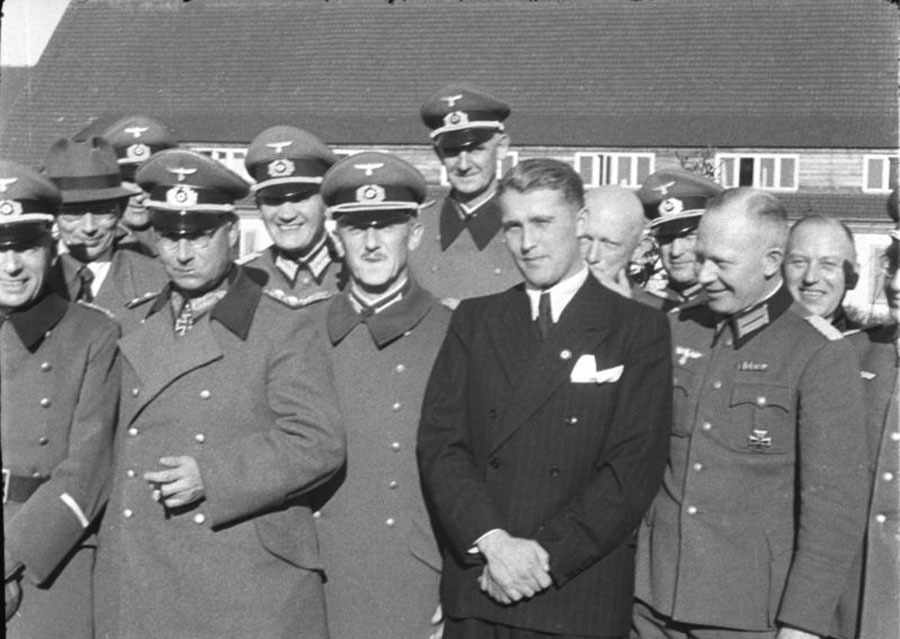In July 1945, US intelligence agencies launched Operation Overcast, which later became known as Paperclip. Within its framework, the United States recruited scientists from Nazi Germany for work, including those involved in crimes against humanity.
"Earn a disaster"
About to use the scientific achievements of the Third Reich, Washington thought long before the end of World War II. In November 1944, the Joint Chiefs of Staff of the United States created the Industrial and Technical Intelligence Committee, which was tasked with the search in Germany for technologies that could potentially benefit the American economy. And the special department of the Air Force intelligence for the collection and analysis of aircraft information compiled a list of German aircraft that were supposed to be captured by US security forces. Special mobile groups searched for the equipment, its drawings, archives and aviation personnel.
According to the military historian Yuri Knutov, the Americans from the moment they entered the war were guided by very pragmatic considerations, trying to "make money on a world catastrophe."
The expert said that in early 1945, one of the internal documents of the German “Association for Defensive Research”, containing the names of German scientists who were involved in defense research, fell into the hands of the special services of the Western Allies. This list was subsequently used by American intelligence agencies to compile a list of researchers of interest to the United States.
In the summer of 1945, American intelligence decided to streamline its work on the search and use in the interests of the United States of carriers of important scientific and technical information. On July 19 (the date of July 6 appears in a number of sources), Operation Overcast began. It was developed by the United States Office of Strategic Services (CIA's predecessor) and approved by the Joint Chiefs of Staff. The United Intelligence Agency was involved in the export of German specialists to the United States.
- V-2 on the Meilerwagen transport and installation trailer
- © Wikimedia Commons / Imperial War Museum
Initially, the activities within the operation concerned 350 German scientists, but soon intelligence began to insist on expanding the scope of activity.
“According to publicly available data, the operation involved a total of at least 1.8 thousand scientists and 3.7 thousand members of their families,” said Yuri Knutov.
According to him, the most interesting shots were exported to the United States, and the rest were resettled in Western Europe and there were subjected to thorough interrogations.
Clean dossiers
“Around the end of 1945 - the beginning of 1946, the operation“ Curtain ”was renamed, for reasons of secrecy, the operation“ Paperclip ”. There is a version that this name is an ironic allusion to the same paper clips that attached photographs of Nazi criminals to the “clean” dossier invented by the US intelligence, ”said Yury Knutov.
According to Dmitry Surzhik, senior researcher at the Institute for General History of the Russian Academy of Sciences, the most important “acquisition” of Americans during this operation was the research team of German rocket engineer Werner von Braun.
“Werner von Braun is the scientist who, in fact, created the Americans their missile program. He led the development of all major US space rockets right up to Saturn 5, on which the Apolon 11 crew went to the moon. In fact, thanks to him, the Americans managed to land a man on the moon, ”the expert said.
As Yuri Knutov recalled, von Braun served as NASA's deputy director and a number of other senior government positions in the US aerospace sector, becoming a very influential and well-off person. In 1955, he officially received United States citizenship.
“At the same time, the Americans completely turned a blind eye to what von Braun did during the war. He was an SS officer, and tens of thousands of concentration camp prisoners were involved in his work in Germany, many of whom died. Von Braun himself later made excuses that, they say, did not know anything about torture and executions, but he was clearly bewildering. There is evidence of prisoners of concentration camps, members of the Resistance that von Braun personally gave instructions to torture them, ”Knutov said.
- Werner von Braun with Third Reich military
- © Wikimedia Commons / Bundesarchiv
According to the historian, Arthur Rudolph was another prominent Nazi rocket engineer who worked for NASA and the U.S. armed forces. During the war, he actively exploited prisoners of concentration camps, and then “forged the defense power” of Washington. When in the 1980s there was talk of his involvement in war crimes, he left America and settled in Germany.
According to Knutov, people who worked for the Nazi regime later received prizes from the Pentagon and the American Institute of Aeronautics and Astronautics, their names are noted in the Hall of Fame of astronauts. Hitler's military doctor Hubertus Strughold was called the father of American space medicine. His name was a special prize and a military medical library. He passed special inspections by US authorities three times. But only after his death did data begin to emerge about Strughold's participation in Nazi experiments on living people, including children suffering from epilepsy.
Hitler's former subordinates also helped the Americans develop military missiles, aircraft, and new types of fuel.
- Werner von Braun in the USA
- © Wikimedia Commons / NASA
In addition, in addition to the Germans, according to Yuri Knutov, the Americans also collaborated with former members of the Japanese special forces, who had put on people experiments in developing bacteriological weapons.
“How morality is combined with the recruitment of war criminals is a complex issue. Especially taking into account the fact that, for example, attacks of V-2 missiles in the United States of Great Britain killed thousands of civilians, ”said Dmitry Surzhik.
According to Yuri Knutov, Operation “Clip” was an “immoral and anti-human project.”
“It was a mind hunt. The US used war criminals to create more sophisticated means of destruction directed against yesterday’s allies, ”Knutov concluded.

